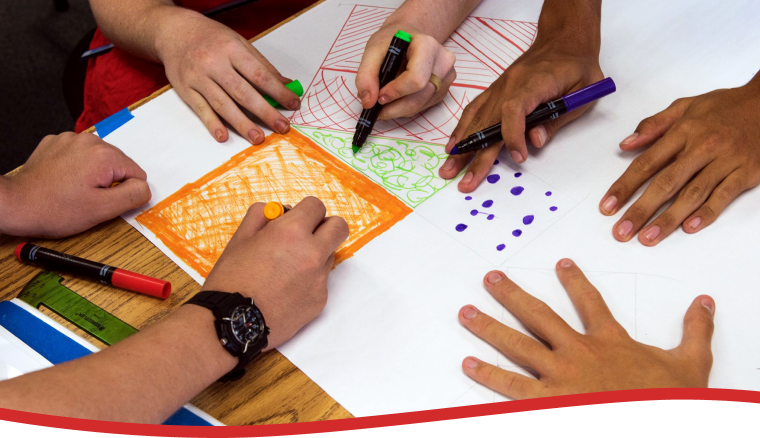
In the Middle School, the curriculum enhances student’s reasoning capacities in their developmental transition from active do-ers and explorers to critical thinkers with acute skills in reasoning, dialogue, and synthesizing information from multiple sources to draw reasoned conclusions. Students are provided with a multi-age academic and social experience to foster greater interpersonal growth.
Through interdisciplinary main lesson blocks such as Meteorology/ Physics/ Industrial Revolution, Renaissance History and the Physics of Simple Machines, Chemistry, Astronomy and Wayfinding, Algebra and Geometry, Physiology and the Physics of Heat, and Explorers of Earth/ Sea/ Sky, Middle School students take an active role in the interpretation and translation of information. Students engage in the scientific process of exploration, logical reasoning in conceptual mathematics, and the study of codified systems of governance. They learn the physical laws of the universe and study the changes and migrations of cultural development in various historical eras. In all these, students engage in the processes of reformulating data, constructing theories, debating complex issues in light of influencing contexts, and drawing conclusions based on well-founded reasoning.
Students are asked to cultivate an awakened consciousness in synthesizing the skills that were developed through imagination and movement in earlier grades.
As these thinking capacities are awakened, the soul-life of the student is nourished through the arts to strengthen feeling-thinking or the empathy of the student.
In the social realm, students’ interpersonal skills and communicative abilities are bolstered by opportunities to engage in projects with practical and “real world” applications. They learn business models to apply to small classroom events or larger projects, organize fundraisers, and take an active involvement in supporting humanitarian advocacy groups.
The combined Middle School classes take field trips that are more ambitious in scope and include physical challenges, community service, and travel that tests students and allows them to build confidence in their capabilities as well as create memorable bonding experiences.
Our school day starts promptly at 7:55am and finishes at 2:45pm. On Wednesdays we finish school at 2:00pm.
GRADE SEVEN
The Renaissance and Age of Exploration represent a turning point in the consciousness of human thinking. The curriculum meets the seventh graders who experience a similar turning point in consciousness with their growing intellect, academic prowess, and active feeling life. Powerful biographies, such as those of Michelangelo, da Vinci, and Galileo demonstrate to the students the struggles and triumphs of the human spirit. Inorganic chemistry, human physiology, and physics provide a framework for understanding the physical world. Algebra, working with negative numbers, and geometry round out the math curriculum. Expository, descriptive, and narrative writing is practiced, and creative writing allows the seventh graders to express thoughts and feelings in an artistic way. Geography ties together other subjects as students begin to see how one’s physical environment affects the development of culture.
- Seventh graders join with eighth-graders in mixed band, strings, and world language classes
- In eurythmy, students are given the opportunity to choreograph their own pieces
- A class trip to Camp Erdman includes a high ropes course that builds trust in one’s self and community
- Copying drawings and paintings of Old Masters, painting frescos, clay modeling, perspective drawing, and veil painting make up the content of the art curriculum
GRADE EIGHT
Growing independence is a hallmark experience for the eighth-grader, and the curriculum appropriately deals with the Age of Revolution, and the growing independence that human beings were seeking. Understanding of revolutions and the need of human beings for freedom grows through the biographies of notable figures such as George Washington, Abraham Lincoln, Martin Luther King, Mahatma Gandhi, and others. The biographies of scientists, such as Einstein, Marie Curie, and Nikolai Tesla, whose work contributed to scientific revolutions, are explored in physics classes, which have a strong component of electricity and magnetism. Students experience the phenomenon of weather in meteorology. Continuing studies in algebra include further work with equations and formulae. The study of geometry, which includes the construction of three-dimensional solids, supports the development of using the power of thought to imagine and create forms in space. An overview of world geography, with a particular emphasis on the geography of Africa, brings together elements of history, science, and culture.
- The Eighth Grade class play, often a production of a Shakespeare comedy, is a grand effort involving the students in set design, costumes, and stage management in addition to acting
- Opportunities to work independently in-class projects and service work grow as the students begin to step away from the class teacher as they approach high school
- Spanish students take responsibility for presenting El Día de los Muertos (Day of the Dead)
- A week-long neighbor islands class trip includes community service, exploration in nature, testing of physical prowess, and growing as a class community